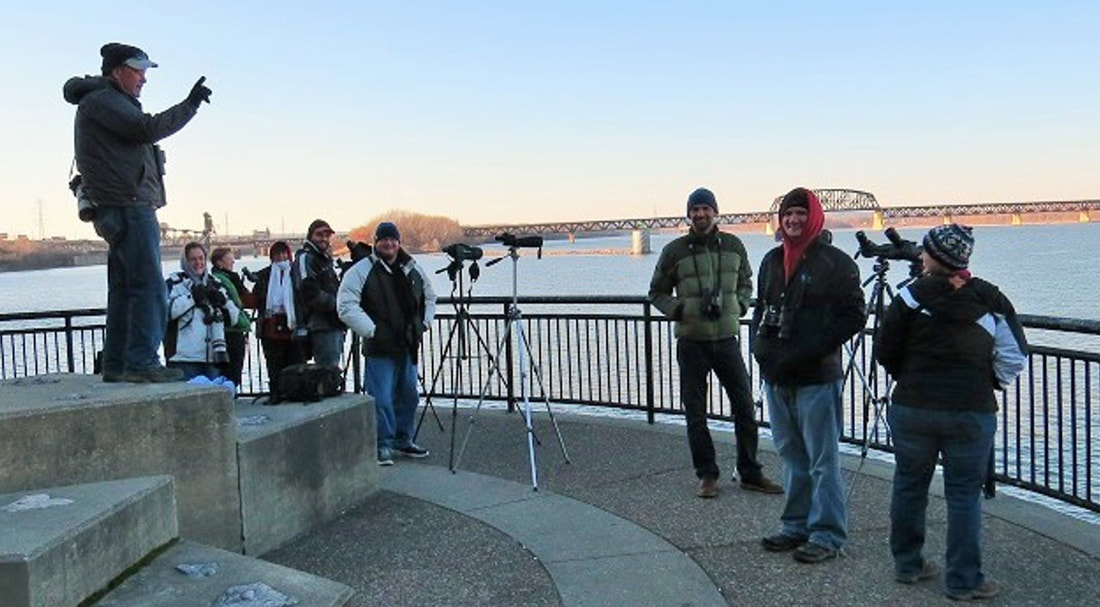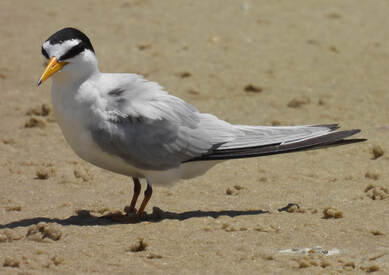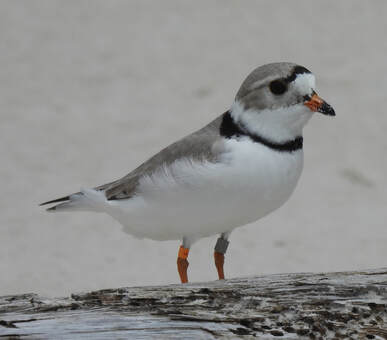BECOME AN ETHICAL BIRDER
|
Do unto owls as you would have done unto you |
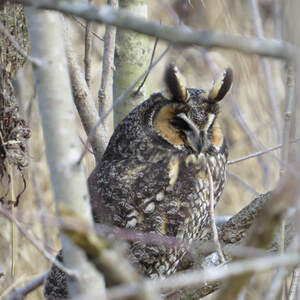
Why do owls fascinate birders and especially bird photographers, often driving them to behave in ways that other species do not inspire?
After all, owls are not – for the most part – among our rarest North American birds. Yes, they can be hard to find, so seeing one is usually a treat for any birder. But why do they so often trigger irrational frenzies?
As owl researcher Denver Holt, the speaker at the 2022 Beckham Bird Club annual meeting, suggested, it may be because owls invite anthropomorphism. They have faces that remind us of ourselves, with wide-set eyes that peer out at us with binocular vision. They look and act smart and calm, encouraging us to ascribe to them those attributes.
Owls are a photographer’s dream. Rather than fly away when approached, owls often sit still , watching us approach and seemingly unperturbed by our presence.
But, as Holt explained, appearances can be deceiving. Owls do indeed get stressed by humans encroaching on their space, even to the point of abandoning nests. In that respect, they are no different than other birds.
Similarly, ethical birding practices around owls should be similar to those used around species that make it clear they are bothered by human presence. First and foremost, maintain a respectful distance and keep noise and commotion to a minimum. Limit use of recording to elicit owls to respond to you.
When photographing owls, do not use flash photography, especially if the bird is flying or hunting. Owls subjected to barrages of flashes show signs of being disturbed or temporarily disoriented.
Owls also tend to bring out bad behavior toward other humans. A pair of Northern Pygmy-owls did just that in Colorado recently, creating traffic issues on a narrow road, irritating local property owners and other recreational users of the area and, worst of all, significantly disturbing a pair of birds that were simply trying to perpetuate their species.
Many social media sites for birders, including several in our area, do not permit disclosing specific locations of owl sightings because it puts the birds at risk of disturbance. As eBird says in its discussion of sensitive species, “Disturbance at (owl) day roosts or use of playback can repeatedly disturb individuals, pairs, or small populations. Large crowds surrounding and following certain owls in winter (sometimes engaging in unethical baiting practices) disrupts natural hunting and exposes owls to great risk from vehicle collisions or habituation to humans.”
eBird currently masks locations for three North American owl species: Spotted Owls, Great Gray Owl, and Northern Hawk Owl, but adds that “we encourage ethical behavior around all owls.”
As noted by eBird, one of the most harmful practices around owls is baiting. Providing food to wild owls is not at all like maintaining backyard feeders, and should be done only by rehabilitators attempting to capture injured birds or by researchers who are banding or tagging owls. The National Audubon Society has a detailed discussion of owl baiting here: https://www.audubon.org/news/why-baiting-owls-not-same-feeding-backyard-birds
In our anthropomorphizing of owls, perhaps we should think of them as the avian celebrities they are and put ourselves in their feathers. Would we want to be subjected to a crush of fans and a barrage of camera flashes every time someone saw us, especially if we’re out on a date or just trying to get some rest? Would we want people throwing hunks of meat or dead rodents our way to get our attention? More likely we’d be like Greta Garbo: I just want to be left alone.
After all, owls are not – for the most part – among our rarest North American birds. Yes, they can be hard to find, so seeing one is usually a treat for any birder. But why do they so often trigger irrational frenzies?
As owl researcher Denver Holt, the speaker at the 2022 Beckham Bird Club annual meeting, suggested, it may be because owls invite anthropomorphism. They have faces that remind us of ourselves, with wide-set eyes that peer out at us with binocular vision. They look and act smart and calm, encouraging us to ascribe to them those attributes.
Owls are a photographer’s dream. Rather than fly away when approached, owls often sit still , watching us approach and seemingly unperturbed by our presence.
But, as Holt explained, appearances can be deceiving. Owls do indeed get stressed by humans encroaching on their space, even to the point of abandoning nests. In that respect, they are no different than other birds.
Similarly, ethical birding practices around owls should be similar to those used around species that make it clear they are bothered by human presence. First and foremost, maintain a respectful distance and keep noise and commotion to a minimum. Limit use of recording to elicit owls to respond to you.
When photographing owls, do not use flash photography, especially if the bird is flying or hunting. Owls subjected to barrages of flashes show signs of being disturbed or temporarily disoriented.
Owls also tend to bring out bad behavior toward other humans. A pair of Northern Pygmy-owls did just that in Colorado recently, creating traffic issues on a narrow road, irritating local property owners and other recreational users of the area and, worst of all, significantly disturbing a pair of birds that were simply trying to perpetuate their species.
Many social media sites for birders, including several in our area, do not permit disclosing specific locations of owl sightings because it puts the birds at risk of disturbance. As eBird says in its discussion of sensitive species, “Disturbance at (owl) day roosts or use of playback can repeatedly disturb individuals, pairs, or small populations. Large crowds surrounding and following certain owls in winter (sometimes engaging in unethical baiting practices) disrupts natural hunting and exposes owls to great risk from vehicle collisions or habituation to humans.”
eBird currently masks locations for three North American owl species: Spotted Owls, Great Gray Owl, and Northern Hawk Owl, but adds that “we encourage ethical behavior around all owls.”
As noted by eBird, one of the most harmful practices around owls is baiting. Providing food to wild owls is not at all like maintaining backyard feeders, and should be done only by rehabilitators attempting to capture injured birds or by researchers who are banding or tagging owls. The National Audubon Society has a detailed discussion of owl baiting here: https://www.audubon.org/news/why-baiting-owls-not-same-feeding-backyard-birds
In our anthropomorphizing of owls, perhaps we should think of them as the avian celebrities they are and put ourselves in their feathers. Would we want to be subjected to a crush of fans and a barrage of camera flashes every time someone saw us, especially if we’re out on a date or just trying to get some rest? Would we want people throwing hunks of meat or dead rodents our way to get our attention? More likely we’d be like Greta Garbo: I just want to be left alone.
BIRDS NESTING – DO NOT DISTURB
We’ve all seen birds nesting in close proximity to humans – American Robins setting up housekeeping on top of a porch light, Northern Cardinals in a bush right next to the back door, Carolina Wrens invading a garage.
In those instances, the birds seem to handle all of the human activity around them in stride. They may get irate now and again, flying off the nest in alarm, but they generally do not get sufficiently disturbed to abandon their eggs or their young. And, as long as you don’t get too close, they will tolerate being photographed.
But that tolerance for intrusion is far from universal. It is the exception. Most birds are sensitive to human presence around their nests, and even those that seem unperturbed may be getting stressed by people in close proximity.
Those tolerant American Robins near your front door may have their nesting success affected by people walking by. If they flush from the nest, their eggs and young may become more susceptible to predation. If the parent birds are reluctant to approach the nest when people are present, the young might be fed less regularly, affecting survival.
Photography of nests is one of the most common human disruptions
So much so that, in some countries – Ireland, for example – it is illegal to photograph nesting birds unless you have been issued a permit by the country’s wildlife protection agency. Ireland’s national birding organization has published an excellent article on the reasons for the photography ban. It can be found here:
https://birdwatchireland.ie/too-close-for-comfort-bird-nests/?fbclid=IwAR0h5z33u84qhU7kxzv_PkUlaLoKCnWP36NDR_GzDPLHIhTFnoZUswVFuMg
The United States has no similar blanket restriction, although strict protections exist in some cases, such as buffer zones around Bald Eagle nests (more on these in a future newsletter). Disturbing nesting birds protected by the Endangered Species Act is also illegal, and photographers who do so can be prosecuted. Federal or state agencies that have nest colonies on their land also may have regulations governing disturbance by photographers or other land users.
Even if the birds in question are not protected from disturbance by law or regulation, ethical birders will act in a manner that eliminates or minimizes negative effects on the nesting birds. The first of those is simply keeping a proper distance from nests and not lingering too long in proximity to the nest.
Photography also should be done at a distance, using long lenses; setting up a blind is another option.
Renowned bird photographer Melissa Groo, who spoke at BBC’s annual meeting a few years ago, has a number of practical suggestions for photographing nesting birds without imperiling the parents, young or eggs. They can be found here:
https://www.audubon.org/news/dos-and-donts-nest-photography
We watch and photograph birds because we love them. It’s always a good idea to give the objects of your affection the space and time to just be themselves.
YOU CAN NEVER HAVE TOO MANY EAGLES
but they still deserve some peace and quiet
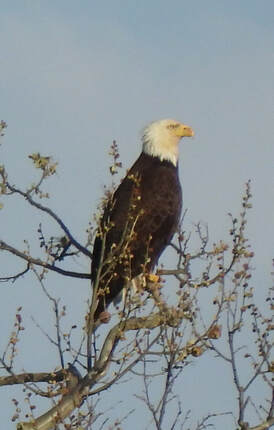
After nearly disappearing from our region midway through the 20th Century, Bald Eagles have made a dramatic comeback, with increasing numbers both nesting a wintering in Kentucky in recent years.
With more Bald Eagles raising families in the state, nests are becoming easier to find, especially since they tend to be used year after year. These conspicuous nests - and the enormous nests constructed and enlarged annually by Bald Eagles tend to be conspicuous - are tempting targets for photographers.
But the fact that our national bird is increasing in the Kentucky should not be interpreted as a signal that they are becoming less vulnerable to interference from humans. Bald Eagles can be very sensitive to disturbance near their nests, including intrusion by birders or photographers into their comfort zone.
That sensitivity varies with individual eagles, but a good rule of thumb is to follow the US Fish and Wildlife Service's recommendation to stay at least 100 meters (330 feet) away from an active nest. Keep in mind also that federal law protects Bald and Golden Eagles and prohibits harassment of those species, including nest disturbance.
Therefore, if you want to observe or photograph eagles, invest in a good spotting scope and a telephoto lens.
The National Audubon Society has an excellent guide to Bald Eagle photography that sets out five rules for doing so in an ethical manner that avoids disturbing these magnificent and very photogenic birds. It can be found at https://www.audubon.org/magazine/winter-2017/five-rules-photographing-bald-eagle-nests.
With more Bald Eagles raising families in the state, nests are becoming easier to find, especially since they tend to be used year after year. These conspicuous nests - and the enormous nests constructed and enlarged annually by Bald Eagles tend to be conspicuous - are tempting targets for photographers.
But the fact that our national bird is increasing in the Kentucky should not be interpreted as a signal that they are becoming less vulnerable to interference from humans. Bald Eagles can be very sensitive to disturbance near their nests, including intrusion by birders or photographers into their comfort zone.
That sensitivity varies with individual eagles, but a good rule of thumb is to follow the US Fish and Wildlife Service's recommendation to stay at least 100 meters (330 feet) away from an active nest. Keep in mind also that federal law protects Bald and Golden Eagles and prohibits harassment of those species, including nest disturbance.
Therefore, if you want to observe or photograph eagles, invest in a good spotting scope and a telephoto lens.
The National Audubon Society has an excellent guide to Bald Eagle photography that sets out five rules for doing so in an ethical manner that avoids disturbing these magnificent and very photogenic birds. It can be found at https://www.audubon.org/magazine/winter-2017/five-rules-photographing-bald-eagle-nests.
